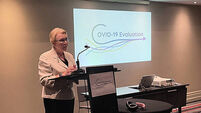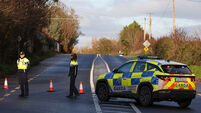Jess Casey: It will take a major logistical operation to reopen our schools

The suggestion that schools may begin to partially reopen shortly has left many in the education sector scratching their heads, writes
While there seems to be a general consensus that it would benefit mental health all around, the finer details on how to co-ordinate thousands of children on their return to the classroom still remain unclear.
The question is now how will that happen while factoring in the new normal when it comes to social distancing.
Sending students back to school for even a staggered one-day week throws out lots of logistical challenges and conundrums.
Like the Government plan to reopen the country in a series of different steps, getting schools reopened will also require careful planning and consultation.
The biggest challenge no doubt will be keeping students physically distanced, should the public health advice to keep 2m apart remain in place. It most likely will.
How implementing this will look will depend on different factors, including the size of a class, and the size of their classroom.
It will also involve working out a system that keeps students physically distanced at their desks.
Drop-offs and collections will also have to be co-ordinated with families, and plans will also have to be made on how to get students to navigate in, out, and around the classroom.
Will health and safety procedures such as fire drills have to be re-examined? It also includes figuring out how to keep students and their friends apart during breaks.
No doubt it will be difficult to impress on young students the need to keep their distance from their classmates.
It goes without saying that teachers and parents will work out an appropriate way of explaining this, especially given some of the more recent difficult conversations they’ve had to have with little ones.
While social distancing might be more easily accepted by an older child as opposed to, let’s say a junior infant, teachers will still have their hands full making sure it’s maintained by teenage students at second level.
Another important aspect of how we will re-open schools that will have to be looked at is the issue of teachers who may themselves be vulnerable to the virus, or who may be living or caring for someone who is.
If the public health advice says that they could potentially be placing themselves at risk by returning to the classroom, will a substitute teacher be drafted in, and will there be availability?
Transport is another aspect that will have to be looked at; Will school buses be in operation for rural schools? Will students in cities and suburbs be able to avail of their usual public transport?
Plans will also have to be put in place for vulnerable students or students who may be living with someone at risk who mightn’t be able to return to the classroom.
Will they have the option to follow along remotely? The same question arises in the potential scenario that sees half a class brought back on one day a week.
Does that mean the rest of the class will be able to follow along remotely on the days they are not physically in school?
Given that the lockdown restrictions have affected vulnerable students, a robust co-ordinated plan for such student needs to be developed by the Department of Education as soon as possible.
Another aspect that undeniably will need to be examined is working hours and holidays.
A lot of this planning and coordination will take time, and most of it will fall on teachers, principals, and schools to enact.
The heads of both the Association of Secondary Teachers of Ireland (ASTI) and the Irish National Teachers’ Organisation (INTO) were coy when asked by Sean O’Rourke on RTÉ Radio 1 if they would be seeking any time in lieu.
Teachers often find their holidays the subject of public commentary but implementing the partial re-opening of schools will be a big job. They deserve to have clear details on what will be expected of them, and what their timetable will look like as a result.
Ireland won’t be the first country to attempt to re-start school; Last week, Denmark became the first EU country to reopen daycare centres and primary schools, sending almost 700,000 young children back into education.
Denmark closed its schools last month, and has so far seen 7,515 people infected, and 360 deaths. In a bid to stick to social distancing restrictions, some Danish primary schools will hold classes outside in marquees.
However, some parents are not happy about the return to education; More than 40,000 people have joined a Danish Facebook group called ‘My child will not be a guinea pig for COVID-19’ — highlighting the importance of support from families.
Meanwhile, Norway also started welcoming children back to pre-school yesterday and, in Germany, some students will also begin to return to school on May 4.
All of these countries have a much smaller student-teacher ratio than Ireland.
Here in Ireland, there’s lots to iron out, and no concrete decisions have been made yet.
What absolutely cannot happen is that it is thrown back on schools to work out the finer points themselves without guidance or consultation first.
Lessons can be learned from the recent redeployment of SNAs which, due to a series of miscommunications, caused serious upset and led to Fórsa, the union representing SNAs and school secretaries, receiving correspondence from several thousand upset members.
If schools do reopen, the Department of Education needs to consult with not only teachers but all school staff.

















